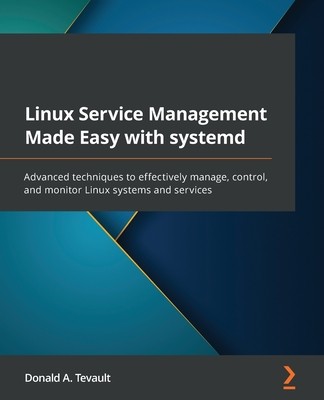
- Išsiųsime per 10–14 d.d.
- Autorius: Donald a Tevault
- Leidėjas: Packt Publishing
- ISBN-10: 1801811644
- ISBN-13: 9781801811644
- Formatas: 19.1 x 23.5 x 2.2 cm, minkšti viršeliai
- Kalba: Anglų
- Extra -15 % nuolaida šiai knygai su kodu: ENG15
Atsiliepimai
Aprašymas
A comprehensive guide for teaching system administrators, developers, and security professionals how to create their own systemd units and maintain system security
Key Features:
- Get well-versed with maintaining and troubleshooting systemd services
- Learn to create, modify, and reload service files and use systemd utilities
- Use cgroups to control resource usage and enhance security
Book Description:
systemd is a new type of Linux init system for today's high-performance, multi-CPU, and multi-core hardware that is now used on all major enterprise-grade Linux distros. The main goal of this Linux systemd book is to help you get an in-depth understanding of systemd to set up your servers securely and efficiently.
This book starts by explaining systemd management, which will help you manage your servers effectively. You'll then learn how to edit and create your own systemd units, which will be particularly helpful if you need to create custom services or timers and add features or security to an existing service. Next, you'll understand how to analyze and fix boot-up challenges and set system parameters. Later, you'll come across cgroups, that'll help you control system resource usage for both processes and users. The book also shows you how cgroups are structured, the differences between cgroups Version 1 and 2, and how to set resource limits on both. Finally, you'll learn about the systemd way of performing time-keeping, networking, logging, and login management. You'll discover how to configure servers accurately and gather system information to analyze system security and performance.
By the end of this Linux book, you'll be able to efficiently manage all aspects of a server running the systemd init system.
What You Will Learn:
- Use basic systemd utilities to manage a system
- Create and edit your own systemd units
- Create services for Podman-Docker containers
- Enhance system security by adding security-related parameters
- Find important information with journald
- Analyze boot-up problems
- Configure system settings with systemd utilities
Who this book is for:
This book is for Linux administrators who want to learn more about maintaining and troubleshooting Linux servers. Aspiring administrators studying for a Linux certification exam and developers looking to learn how to create systemd unit files will also find this book useful. Additionally, this book will be helpful for security administrators who want to understand the security settings that can be used in systemd units and how to control resource usage with cgroups. Working knowledge of basic Linux commands is assumed.
EXTRA 15 % nuolaida
Kupono kodas: ENG15
Akcija baigiasi už 3d.08:13:07
Nuolaidos kodas galioja perkant nuo 10 €. Nuolaidos nesumuojamos.

- Autorius: Donald a Tevault
- Leidėjas: Packt Publishing
- ISBN-10: 1801811644
- ISBN-13: 9781801811644
- Formatas: 19.1 x 23.5 x 2.2 cm, minkšti viršeliai
- Kalba: Anglų
A comprehensive guide for teaching system administrators, developers, and security professionals how to create their own systemd units and maintain system security
Key Features:
- Get well-versed with maintaining and troubleshooting systemd services
- Learn to create, modify, and reload service files and use systemd utilities
- Use cgroups to control resource usage and enhance security
Book Description:
systemd is a new type of Linux init system for today's high-performance, multi-CPU, and multi-core hardware that is now used on all major enterprise-grade Linux distros. The main goal of this Linux systemd book is to help you get an in-depth understanding of systemd to set up your servers securely and efficiently.
This book starts by explaining systemd management, which will help you manage your servers effectively. You'll then learn how to edit and create your own systemd units, which will be particularly helpful if you need to create custom services or timers and add features or security to an existing service. Next, you'll understand how to analyze and fix boot-up challenges and set system parameters. Later, you'll come across cgroups, that'll help you control system resource usage for both processes and users. The book also shows you how cgroups are structured, the differences between cgroups Version 1 and 2, and how to set resource limits on both. Finally, you'll learn about the systemd way of performing time-keeping, networking, logging, and login management. You'll discover how to configure servers accurately and gather system information to analyze system security and performance.
By the end of this Linux book, you'll be able to efficiently manage all aspects of a server running the systemd init system.
What You Will Learn:
- Use basic systemd utilities to manage a system
- Create and edit your own systemd units
- Create services for Podman-Docker containers
- Enhance system security by adding security-related parameters
- Find important information with journald
- Analyze boot-up problems
- Configure system settings with systemd utilities
Who this book is for:
This book is for Linux administrators who want to learn more about maintaining and troubleshooting Linux servers. Aspiring administrators studying for a Linux certification exam and developers looking to learn how to create systemd unit files will also find this book useful. Additionally, this book will be helpful for security administrators who want to understand the security settings that can be used in systemd units and how to control resource usage with cgroups. Working knowledge of basic Linux commands is assumed.




Atsiliepimai